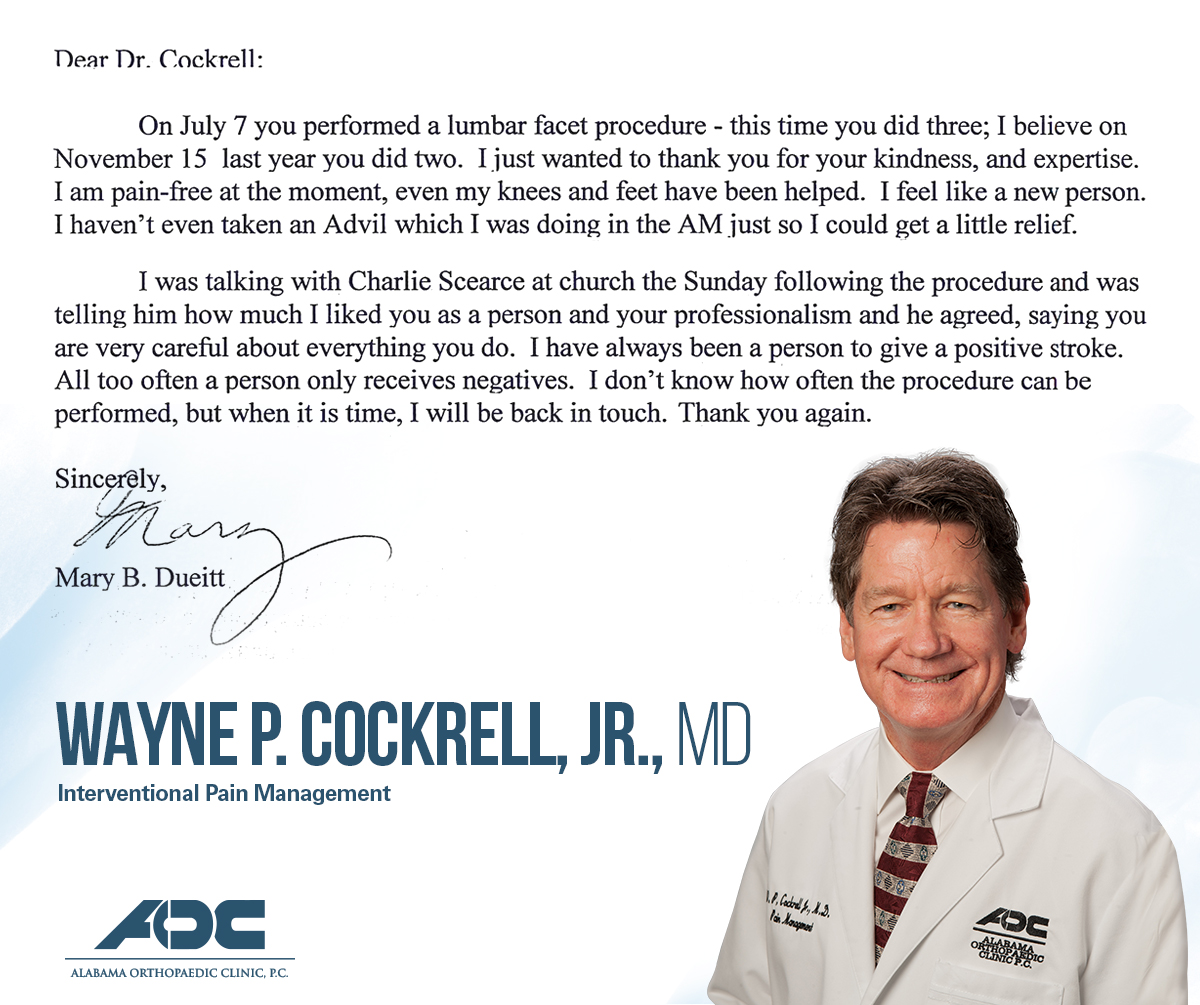
AOC Doctors pride themselves on providing excellent patient care. Dr. Cockrell received this letter from a patient expressing her gratitude for his “kindness and expertise.” Now, after her procedure, she is able to walk pain-free.
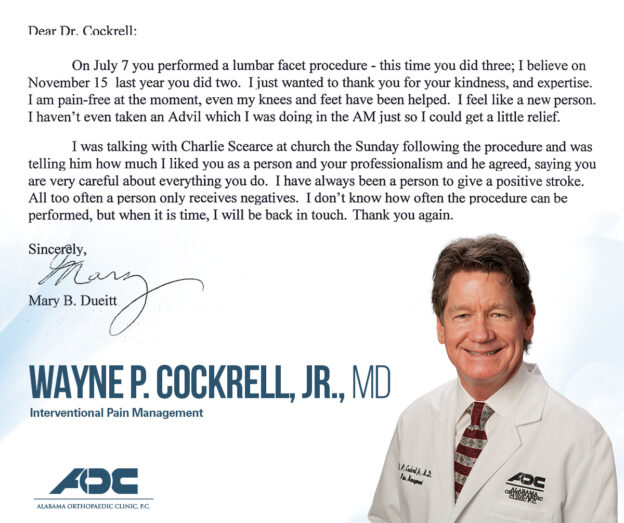

AOC Doctors pride themselves on providing excellent patient care. Dr. Cockrell received this letter from a patient expressing her gratitude for his “kindness and expertise.” Now, after her procedure, she is able to walk pain-free.
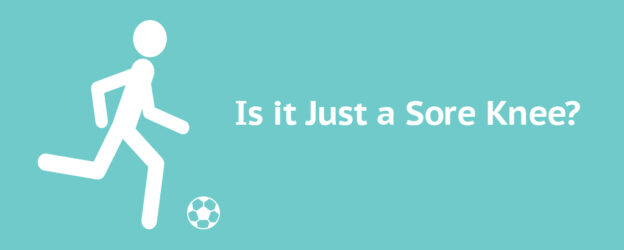
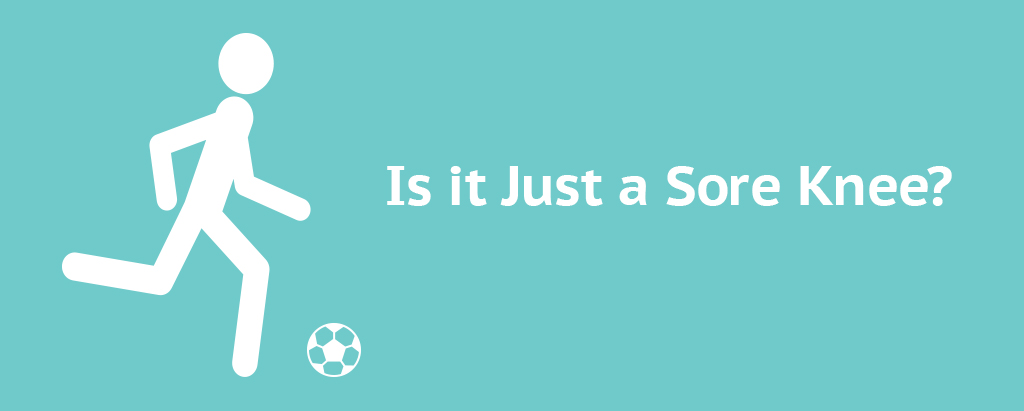
It’s a fact, kids play hard. However, while they’re playing and having fun, children don’t realize they are sore until it’s time for bed. As their bodies begin to relax, sore muscles and joints begin to ache; these aches are commonly called growing pains. However, if pain persists, it may be more than a sore muscle or joint, it could be juvenile arthritis. Here are a few tips to help you know the difference.
Growing Pains vs Juvenile Arthritis
What are growing pains?
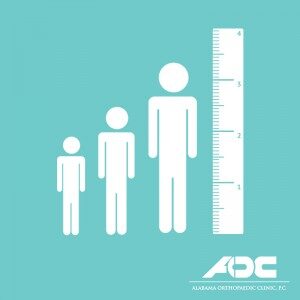
Children who complain of growing pains, often describe pain or discomfort in their legs or arms. Growing pains tend to affect children at night; it is not uncommon for aches to wake children from their sleep. Don’t panic, although these aches are called growing pains, there is no evidence linking growth with pain. After all a child’s rate of growth is too piecemeal to cause pain.
Symptoms of Growing Pains
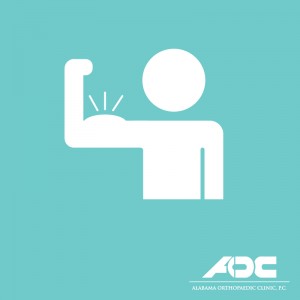
Symptoms of growing pains are pains in the muscle, rather than in the joints. Common spots include the front of the thighs, the calves and the backs of the knees. Pain typically does not last for long periods of time. If pain does persist, it may be time to call a pediatrician. Quick tip: a warm bath before bed can help soothe sore muscles.
What is Juvenile Arthritis?
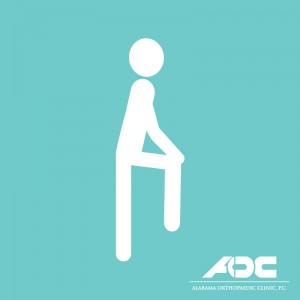
Yes, children can get arthritis. Juvenile arthritis affects children under the age of 17. Children who have juvenile arthritis may experience persistent pain, swelling and stiffness in their joints.
Symptoms of Juvenile Arthritis
Symptoms to watch out for are tenderness, pain, or swelling of the joints, limited range of motion, joint stiffness, and fatigue. If joint pain persists more than a week, make an appointment to see a doctor ASAP.
Like AOC on Facebook
Follow AOC on Twitter
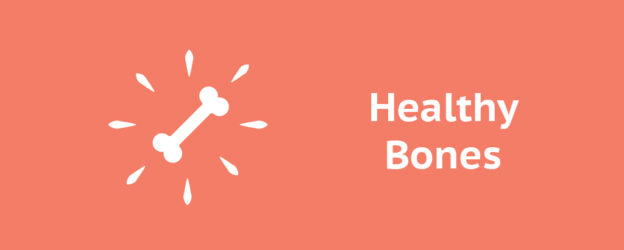
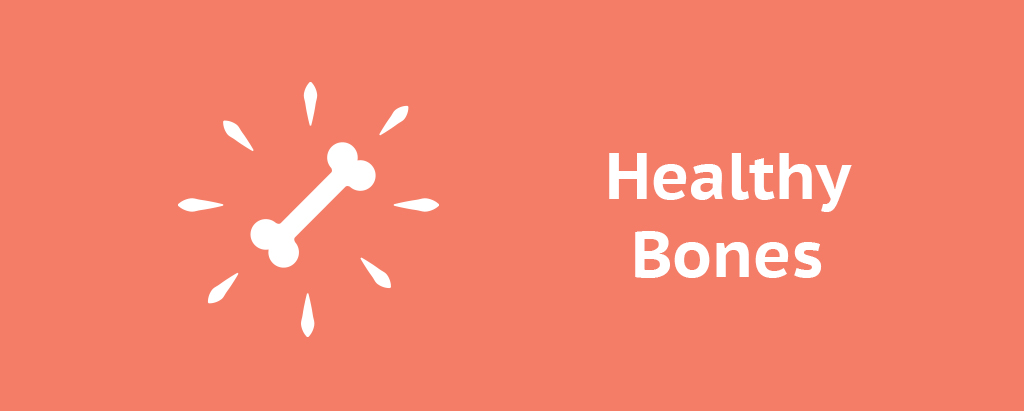
If we’ve said it once, we’ve said it a hundred times, but having healthy bones is very important. AOC knows everyone is busy but making sure you have healthy bones is not a hard task. Here we have 6 easy tips to follow for strong bones:
1. Be sure to have plenty of calcium.
Calcium is a mineral our bodies need in order to live. Our bodies don’t produce calcium so it’s important to eat foods with calcium in them or the body takes it from other places, like your bones. Eat plenty of green vegetables or foods high in calcium, and make sure you get the allotted daily amount. How much do you need? Use this calcium calculator to find out: http://www.iofbonehealth.org/calcium-calculator
2. Also, Vitamin D.
Calcium and Vitamin D go together because your body requires Vitamin D to absorb the calcium. Kids need it to build strong bones and adults need it to keep their bones healthy. So how do you get Vitamin D? Sunlight, food or supplements. Foods that have Vitamin D are fatty fish, and some dairy products or orange juices.
3. Vitamin K is important as well.
Vitamin K helps the calcium bind to the bone matrix. So having the proper amount along with Vitamin D is integral to the calcium intake. Dark green vegetables, like spinach, kale and turnips have Vitamin K, so eat plenty of veggies with your meals.
4. Potassium; your natural protector.
Potassium works to protect your bones against the metabolic acids in your body. So having enough helps protect your bones from breakdown. You can get most of your potassium from eating fruits, vegetables, seeds and certain spices.
5. Exercise those bones.
Bone is a living tissue that strengthens through exercise, along with getting the right amount of nutrients. Adults and children who exercise usually have higher bone density and strength, protecting them from breaks and fractures. So get up and get moving! Try some of these easy exercises.
6. Cut out these things- caffeine, alcohol, and cigarettes.
All 3 of these things can hinder calcium absorption into your bones, thus making them weak.
Next time you think about what you are going to eat for dinner, try to remember which foods contain the right nutrients that are good for your bones. If it helps, make a cheat sheet and take it with you, so you know what to buy from the grocery store or order from the restaurant. If you feel you are not getting enough of these nutrients, try taking daily supplements.
If you need help in a specific area or want an expert opinion, give us a call at Alabama Orthopaedic Clinic, 251-410-3600, or visit us at www.alortho.com.
Like AOC on Facebook
Follow AOC on Twitter
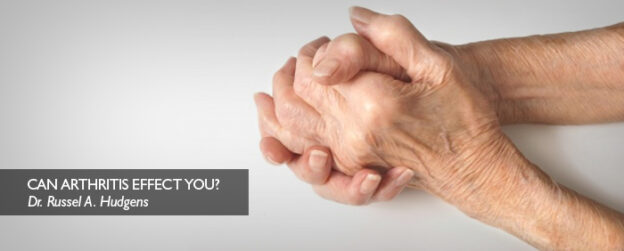
Arthritis is the most common cause of disability in the United States. With over 100 types of arthritis, we tend to focus on the most common type, osteoarthritis, also called degenerative joint disease, and the other most common type, inflammatory arthritis. This ailment affects up to 80% of people during their lifetime.
Osteoarthritis is caused by destructive wear and tear of the articular cartilage which covers the end of joints. All joints have a cartilaginous end to the bone. This tissue is well organized and is very smooth with low friction; therefore it takes multiple years and multiple cycles for a joint to typically wear out.
There are multiple causes for this wear. It can be due to simple aging changes, hereditary factors, malalignment of the joints, or excessive strain to the joints such as repetitive wear or excessive weight.
Patients who come to Alabama Orthopaedic Clinic for arthritis pain are often diagnosed by the history of the joint pain and stiffness, the physical signs of joint pain, stiffness, malalignment, increased warmth or swelling, and confirmed by other diagnostic tests such as x-rays. The diagnosis of inflammatory arthritis can be assisted with x-rays, but are more typically diagnosed by laboratory tests such as rheumatoid factor, a sedimentation rate and an antinuclear antibody test or screen.
Unfortunately, there is no known cure for arthritic conditions; however, great progress has been made over the recent years in trying to find disease-modifying agents that can potentially slow the process of the development of arthritis. The initial treatment for arthritic conditions is related to activity. This may be in the form of exercise, stretching, physical therapy or occupational therapy. Next, diet may be important. Not only does weight loss help joint wear, it may reduce some of the strain on the joint and certain types of diets may reduce the actual causes of inflammation in the body. Medications which are frequently used for this include categories such as nonsteroidal anti-inflammatories.
If you are having symptoms or problems occurring from arthritis, please call and schedule and appointment today, 251-410-3600 or visit alortho.com.
LIKE AOC on Facebook
Follow AOC on twitter
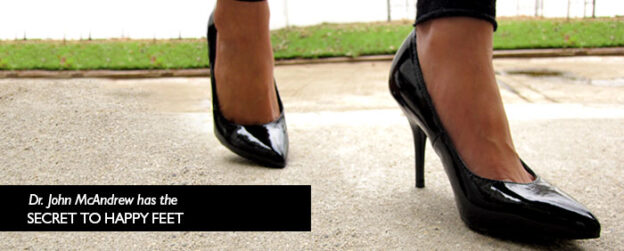
There is not a day in the office when someone does not discuss shoes. Proper protection and comfort are critical for our feet, as they are continuously subjected to high stress and injury with normal daily use. Shoe-wear issues are a constant balancing act between the need of protection and comfort versus style and social expression.
Women, particularly, can struggle with the shoe dilemma. While heeled, fashionable pumps, can seem to be a good fashion choice, the consequences of prolonged wear could make them less desirable. The constant use of heeled and pointed pumps will ultimately contribute heavily toward heel cord contracture, insertional spurs on the back of the heel, toe deformities including bunion and hammer toes; as well as forefoot nerve compression syndromes. Moreover, they can be unstable and subject the wearer to greater risk of ankle sprains and tendon injuries.
Flip-flops on the other hand are comfortable, but non-supportive. They leave the foot largely unprotected against injury. Walking barefoot carries the non-supportive risk to its ultimate, and is particularly dangerous in the diabetic patients with nerve sensibility issues.
Moderation is the key to life, and footwear is no exception. Fashionable, heeled pumps and casual un-supportive flip flops are all appropriate and good in the right setting, but are not to be worn most of the time.
Remember, whatever the shoe you choose, first and foremost it must fit. Uncomfortable shoes by definition do not fit, and will reliably lead to structural and painful problems with the feet.
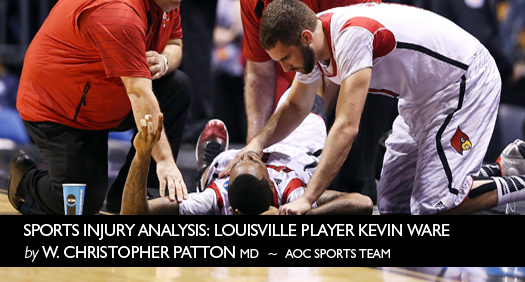

Did you see the Gruesome injury sustained by Kevin Ware? Pitino said “it was as bad as I’ve ever been.” Ware was taken to the Methodist Hospital, which is two miles away from the arena. He had surgery later Sunday night and will remain in Indianapolis for at least two days.
The open (compound) tibia fracture sustained by Ware is a serious injury with several possible short term and long term complications. Placing a rod into the bone to stabilize and realign it is the preferred method, if possible. Infection is one of the main concerns given the fact that the bone broke through the skin. Open tibia fracture can potentially take months to heal. However, return to basketball is possible.
We will keep up with Kevin’s healing progress and we hope this young athlete has a full recovery and is quickly back on the court competing at a high level again soon.
Click her for complete article, Louisville’s Kevin Ware suffers gruesome broken leg by Jeff Goodman
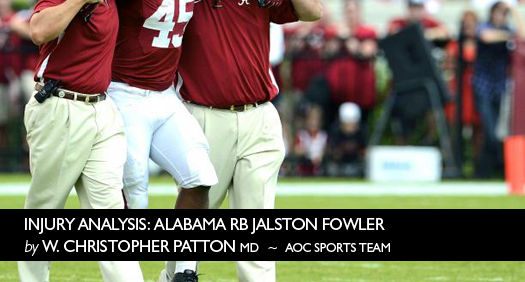

The recent injury to the knee of University of Alabama RB Jalston Fowler reminds us of how debilitating such injuries can be. Although no official report of the exact structures that have been damaged has been released, the video shows hyperextension of his knee which can damage major ligaments such as the anterior cruciate ligament (ACL), posterior cruciate ligament (PCL), side ligaments (collateral ligaments) or cause fractures to occur.
Seventy percent of non-contact injuries that result in swelling within one hour are ACL injuries. Furthermore, the C-shaped cartilages, called the menisci, can be torn during sporting injuries.
Treatment of knee injuries during football or other sports is most often treated arthroscopically– meaning via small incisions using a small camera to assist in visualizing the injured structures. Over 400,000 ACL reconstructions alone are done in the United States yearly.
According to R. Kavner’s article on collegesportsblog.dallasnews.com, Alabama coach Nick Saban announced Monday that running back Jalston Fowler will have surgery on his injured knee and is most likely going to be out for the season. Regaining muscle tone, control and joint range of motion is important if returning to sports is desired. This can take many months of hard work and dedication. AOC hopes Jalston has a good recovery and can return to the sport as soon as he is able.
Click here to see more info about Alabama Orthopeadic Clinic
Like us on Facebook
Follow us on Twitter
Concussions: “When in doubt, sit them out.”
An estimated 300,000 sports-related traumatic brain injuries occur in the United States each year. 63,000 of these injuries occur at the high school level. Football causes 63% of these injuries, and girls’ soccer is the second leading cause. Most of these types of head injuries recover within a week, but some can take a month or longer to recover. However, unfortunately, there are still approximately 900 deaths a year from sports-related traumatic brain injuries (concussions).
So, what can be done to decrease these numbers? Makes sure athletes, coaches, and parents know the signs and symptoms of concussion. Athletes should be encouraged to speak with someone (teammate, parents, coaches or healthcare professional, etc.) if they “don’t feel right” after a hard hit to the head. If at all possible, make sure your school has a Certified Athletic Trainer (ATC) present at games and practices. ATCs are trained to recognize, evaluate, and treat athletes who show signs and symptoms of concussions. They work closely with the team physician to get athletes the care they need quickly and to keep them safe. They will also work with the treating and/or team physician, coaches, parents and athlete to transition them back into the game once their symptoms have resolved and have been cleared by the physician. If your school does not have an ATC, make sure the coaches follow the general guideline, “When in doubt, sit them out.”
March is Alabama Brain Injury Awareness Month and National Athletic Training Month.
For more head injury information, please go to nata.org or alabamabraininjuryawareness.org
Click here for more information about Alabama Orthopaedic Clinic, P.C.
LIKE AOC on Facebook